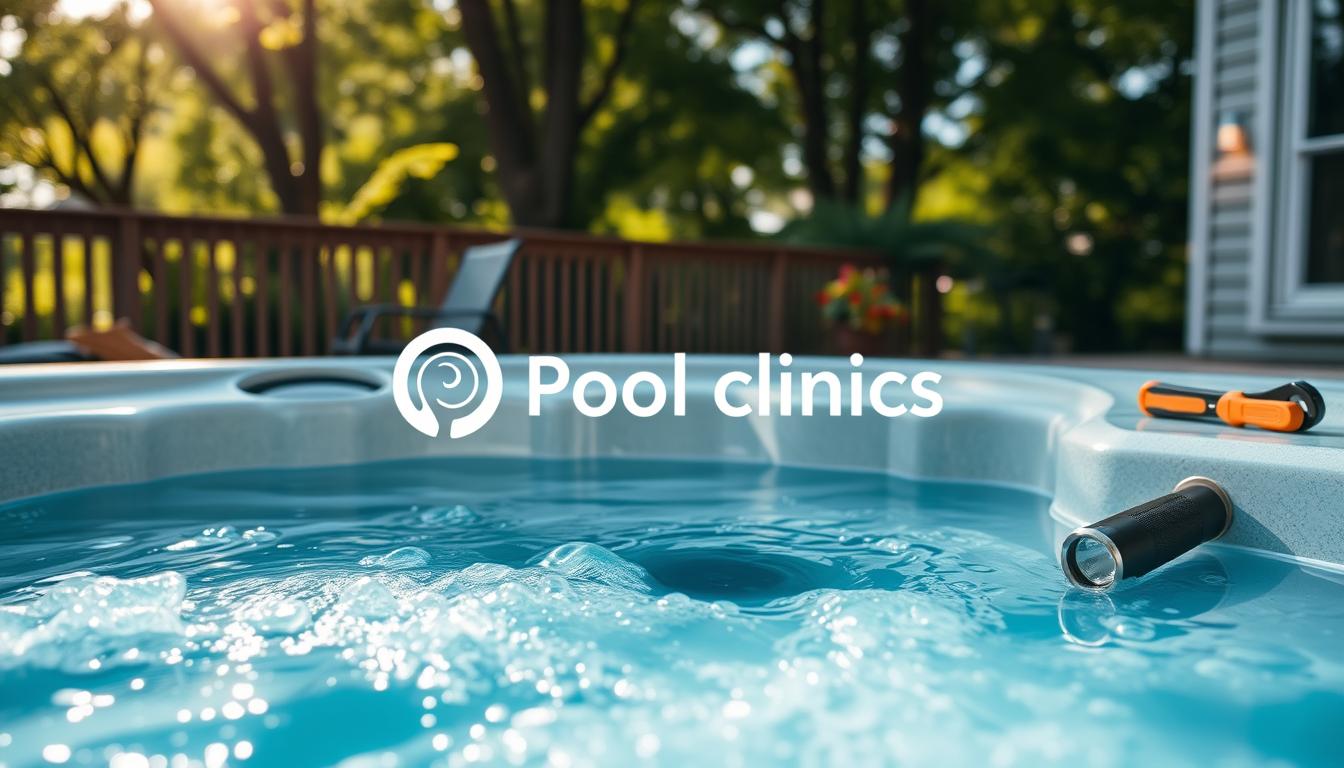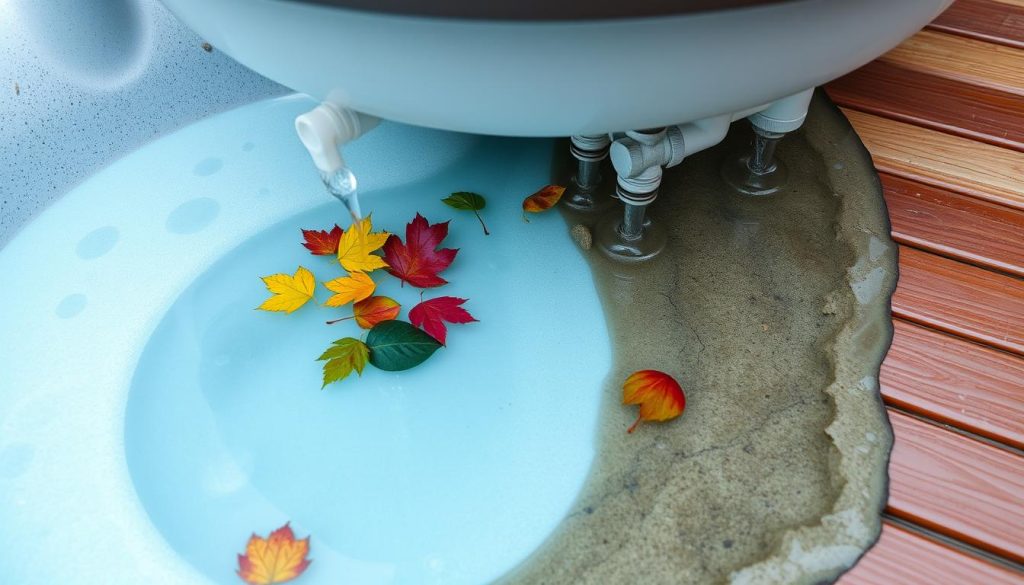
Hot tub leaks can cause higher water usage and energy costs. They may also damage the surrounding area if ignored. Finding leaks is vital for your spa’s longevity and efficiency.
Leaks can occur in jets, seals, or plumbing connections. Worn-out seals, loose fittings, or cracks in the spa shell often cause them. Spotting the leak source is crucial to fix the problem.
This guide will help you spot hot tub leaks and fix them. Follow these steps and maintain your spa regularly. Your hot tub will remain a relaxing retreat for years.
Key Takeaways
- Regularly inspect your hot tub for signs of leaks, such as unexpected drops in water level or wet spots around the spa.
- Common leak sources include jets, pumps, and plumbing connections.
- Use visual inspection and dye tests to pinpoint the location of a leak.
- Address leaks promptly to prevent water loss, damage to components, and increased energy costs.
- Incorporate regular maintenance practices, such as cleaning the filter cartridge and maintaining water chemistry, to prevent leaks and ensure the longevity of your hot tub.
Identifying Signs of a Hot Tub Leak
Spotting hot tub leaks early is key to maintaining your spa. Quick detection prevents damage and saves money. Let’s look at signs that your hot tub might be leaking.

Unexpected Drops in Water Level
A major sign of a leak is a steady drop in water level. Normal loss is 1-2 inches weekly from use and evaporation. Anything more could mean a leak.
If you’re refilling your hot tub more often than usual, investigate for leaks. This could save you from bigger problems later on.
Wet Spots Around the Hot Tub
Wet spots or puddles near your spa base may indicate a leak. Look for water collecting when the tub isn’t in use. These wet areas can vary in size depending on the leak’s location and severity.
Visible Dripping from Components
Water dripping from specific parts is a clear leak sign. Watch for issues in these areas:
- Jet fittings: Loose or damaged jet fittings are a common source of leaks in hot tubs. Check for any water dripping or seeping from the jets.
- Pump seals: If you notice water pooling around the pump housing, it may indicate a failing pump seal, leading to leaks.
- Plumbing connections: Inspect the plumbing system for any loose connections, cracks, or damage that could be causing water loss.
Address any visible dripping or water buildup near these parts quickly. This will help prevent further damage to your hot tub.
| Leak Source | Potential Cause | Action Required |
|---|---|---|
| Jet Fittings | Loose or damaged fittings | Tighten or replace fittings |
| Pump Seals | Worn out or failing seals | Replace pump seals |
| Plumbing Connections | Loose, cracked, or damaged pipes | Repair or replace affected components |
Know these common signs of hot tub leaks to catch problems early. Regular checks and quick action can save time and money.
By staying alert, you’ll keep your hot tub in top shape. This ensures it remains a relaxing retreat for years to come.
How to Find a Leak in a Hot Tub
Finding hot tub leaks can be challenging. But with the right approach, you can locate and fix the issue. A thorough inspection and dye test are key steps.
Proper maintenance reduces leak risks. It also ensures your hot tub lasts longer. Understanding common leak sources is crucial for effective troubleshooting.
Visual Inspection of Hot Tub Components
Start by checking all hot tub parts. Look for water pooling, rust, or cracks. Pay attention to connections between components.
These are often weak points for leaks. Address any visible damage quickly. This prevents further leakage and more serious problems.
Using a Dye Test to Pinpoint Leaks
A dye test helps find hidden leaks. Add leak detection dye near suspected areas while the hot tub runs. Watch how the dye moves in the water.
It will be drawn to the leak source. This method shows the exact leak location. It makes repairs easier and more targeted.
Glow Leak helps trace leaks with pinpoint accuracy, making repair processes simpler and saving time and resources for hot tub maintenance professionals.
Common Leak Sources: Jets, Pumps, and Plumbing
Knowing common leak sources helps focus your inspection. Main leak areas include jet fittings, pump seals, and plumbing connections.
- Jet fittings: Leaks can occur around the gaskets or connections of the jets, often requiring replacement of the gaskets or entire jet assembly.
- Pump seals: Circulation pump leakage is a common issue, with potential causes being the shaft seal, unions, or the volute. Replacing the faulty components is typically necessary to resolve the leak.
- Plumbing connections: Inspecting all connections, such as pipes and valves, is crucial. Some may require simple tightening, while others may need replacement.
| Leak Source | Common Causes | Repair Methods |
|---|---|---|
| Heater | Age, corrosion, damage | Replace entire heater or specific components |
| Valves | Wear, improper installation | Tighten connections, replace valves |
| Spa Shell | Damage to components attached to the shell (e.g., jets) | Replace damaged components, apply sealant |
Visual checks and dye tests help find hot tub leaks. Focus on common leak sources for effective repairs. Regular maintenance prevents leaks and extends your hot tub’s life.
Conclusion
Fixing hot tub leaks is vital for your spa’s longevity and function. DIY methods like visual checks and dye tests can solve many issues. However, complex problems may need professional hot tub repair for tailored solutions.
Regular maintenance is key to prevent future leaks. Check seals and gaskets for wear. Keep water chemistry balanced to avoid component damage. In cold areas, proper winterization stops pipes from cracking.
Understanding leak identification and repair keeps your hot tub in top shape. Professional repairs can lead to long-term savings. They provide lasting fixes and expert prevention tips.
With the right approach, you can enjoy a trouble-free spa experience for years. Invest in proper maintenance and timely repairs for optimal hot tub performance.







